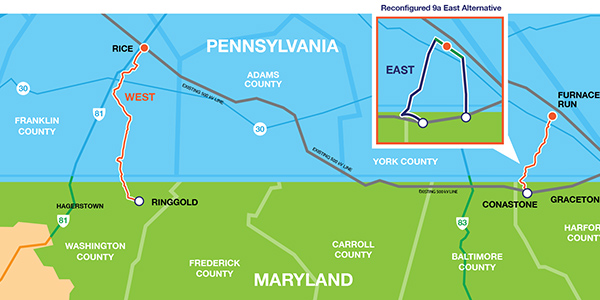By Christen Smith
VALLEY FORGE, Pa. — Transource Energy’s alternative configuration for its Independence Energy Connection project doesn’t pass PJM’s cost-benefit test, LS Power said last week.
Sharon Segner, vice president of LS Power, told the Transmission Expansion Advisory Committee on Thursday that her company’s review of the newly proposed path for the eastern segment of the project only carries a benefit-cost ratio of 1, far below PJM’s 1.25 threshold.
PJM’s analysis, however, produces a 1.6 cost-benefit ratio. Nick Dumitriu, of the RTO’s market simulation department, said the new configuration — which scraps plans for a nearly 16-mile-long transmission line in favor of tying into existing infrastructure in York County, Pa., and Harford County, Md. — will cost $496.17 million and realize $844.81 million in congestion benefits.
Segner said PJM’s base case used to calculate the ratio doesn’t consider the impact of a nearby project that would alleviate congestion on the Hunterstown-Lincoln 115-kV line. PJM plans to present both projects to the Board of Managers in December for inclusion in the Regional Transmission Expansion Plan, Dumitriu said.
“We just want to get to the right answer, and I think that’s everyone’s objective,” Segner said. “These areas are somewhat interrelated, and that’s where it gets kind of complicated. … We have reason to believe the cost-benefit ratio will look pretty different when the Hunterstown project is in the model.
“It may make sense to go ahead with the settlement version, but it should be based on the correct analysis,” she added.
Transource filed the second configuration for the IEC East project with Maryland and Pennsylvania regulators last month after settling with landowners and state officials long opposed to the original route. (See Transource Files Reconfigured Tx Project.)
PJM selected the original configuration for the $383 million IEC — its largest market efficiency project to date — during the 2013/14 long-term planning window to address congestion in the AP South interface. The RTO has since reviewed its benefits to the grid six times, determining in each round that the project remains the most effective way to reduce load costs.
The RTO’s most recent analysis, completed in September, determined the original configuration would generate a $856 million reduction in congestion costs over the next 15 years, with a benefit-cost ratio of 2.1 — well above PJM’s 1.25 threshold required for inclusion in its RTEP.
Protesters argued, however, that the need for the eastern segment of the project could be met by using towers for existing 230-kV lines. Maryland’s Power Plant Research Program urged the state’s Public Service Commission to suspend the project while PJM studied the market efficiency of this alternative and three others — a request that was granted in January. (See More Info Needed on Tx Line Options, MD PSC Says and Cancel Transource Line, Md. Panel Says.)
PJM’s analysis determined that the protesters’ preferred configuration would require upgrades at the Furnace Run substation in York County in order to alleviate potential reliability violations. The plan will cost $125 million more than the original IEC and produce $12 million less in congestion benefits to the region, according to PJM’s most recent market efficiency update.
Still, Transource and the protesters have settled on the alternative configuration, despite the reduced benefits and additional cost. Both plans sit before regulatory agencies in Maryland and Pennsylvania awaiting a final decision.
Meanwhile, PJM must update its RTEP to include the alternative plans for the IEC.
“We are going to give the board the complete picture of what’s going on,” said Ken Seiler, PJM’s vice president of planning. “There’s a lot of moving parts and a lot of variables, and we will make sure the board has the right information.”
Seiler added that “at some point,” the plans must move forward. “The area is congested and will be congested until we get some of these projects built,” he said.
Alex Stern, manager of transmission strategy and policy for Public Service Electric and Gas, agreed.
“At some point, you need to focus on what needs to get done,” he said. “I think PJM is doing that and obviously that’s part of prioritizing, and you need to prioritize what’s in the best interest of planning and developing a cost-effective grid versus what’s in the best interest of needlessly perpetuating a competitive process.”







